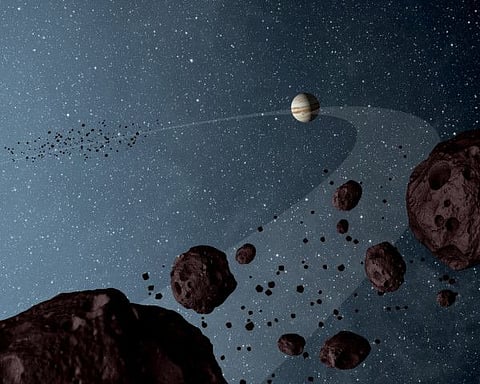Abu Dhabi-based researcher contributes to new study on Jupiter Trojan asteroid swarms
Scientist at NYU Abu Dhabi part of international team probing the celestial clusters

Abu Dhabi: An international team of scientists, including NYU Abu Dhabi researcher Nikolaos Georgakarakos, has developed new insights that may explain the numerical asymmetry (unevenness) of the L4 and L5 Jupiter Trojan swarms, two clusters containing more than 10,000 asteroids that move along Jupiter’s orbital path around the sun.
Scientists have known that there are significantly more asteroids in the L4 swarm than the L5 swarm, but have not fully understood the reason for this asymmetry. In the current configuration of the Solar System, the two swarms show almost identical dynamical stability and survivability properties, which has led scientists to believe that the differences came about during earlier times of our Solar System’s life. Determining the cause of these differences could uncover new details about the formation and evolution of the Solar System.
“The characteristics of the current Solar System hold as-yet unsolved mysteries into its formation and early evolution,” said Georgakarakos.
“The ability to successfully simulate an event from an early stage of the Solar System’s development and apply those results to modern day questions can also be a key tool as astrophysicists and other researchers work to learn more about the dawn of our world,” he added.
Trojan swarms
In the paper published in the journal Astronomy & Astrophysics, scientists from the US, Japan, and China, led by Jian Li from Nanjing University, wrote: “We propose that an outward, in terms of distance to the Sun, fast migration of Jupiter can distort the configuration of the Trojan swarms, resulting in more stable orbits in the L4 swarm than in the L5 one.”
“This mechanism, which temporarily induced different evolution paths for the two asteroid groups that share the orbit of Jupiter, provides a new and natural explanation for the unbiased observation, that the L4 asteroids are about 1.6 times more than the asteroids in the L5 swarm,” Li noted.
Orbital instability
The model simulates the orbital evolution of Jupiter, caused by a planetary orbital instability in the early Solar System. This led to the outward migration of Jupiter at a very high speed; a migration that the researchers hypothesize was the possible cause of the changes in the stability of the nearby asteroid swarms.
Future models could expand on this work by including additional aspects of the evolution of the Solar System, which could depict it with improved accuracy. This could include simulating the fast migrations of Jupiter at different speeds, and the effects of nearby planets.
Sign up for the Daily Briefing
Get the latest news and updates straight to your inbox


